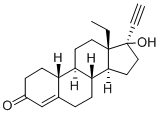Tropinone
Synonym(s):8-Methyl-8-azabicyclo[3.2.1]octan-3-one
- CAS NO.:532-24-1
- Empirical Formula: C8H13NO
- Molecular Weight: 139.2
- MDL number: MFCD00005549
- EINECS: 208-530-6
- SAFETY DATA SHEET (SDS)
- Update Date: 2025-02-24 16:12:34

What is Tropinone?
Description
Since the 4th century BCE,?Mandragora?spp. (mandrake),?Atropa belladonna?(deadly nightshade), and other plants in the Solanaceae family were known to have medicinal uses—and to be poisonous. By the 19th century, scientists had discovered that one of the most important bioactive components of these plants was atropine. It was prepared in pure form by pharmacist Heinrich F. G. Mein in 1831 and synthesized by chemist Richard Willst?tter in 1901.
Willst?tter synthesized atropine from tropine and tropic acid, both of which must be made separately from available materials. The alcohol tropine can be prepared from its ketone form tropinone, which at the time was difficult to synthesize. Willst?tter’s convoluted synthesis of tropinone from cycloheptanone required 15 steps and had an overall yield of 0.75%.
When atropine was needed to overcome the effects of nerve gases during World War I, very little was available. That’s when Britain’s Sir Robert Robinson developed his classic one-pot, concerted synthesis of tropinone from succinaldehyde, methylamine, and acetonedicarboxylic acid. The original yield was 17%; it was later improved to an astounding 90%.
To this day, tropinone’s only practical use is as a precursor to atropine. Robinson was awarded the 1947 Nobel Prize in Chemistry—however, not for his tropinone synthesis.
Description
Tropinone (8-methyl-8-azabicyclo[3.2.1]octane-3-one)(7) is the simplest plant tropane and is the first intermediate in the biosynthesis of tropane alkaloids. Studies have called 4-(1-methyl-2-pyrrolidinyl)-3-oxobutanoic acid as an intermediate metabolite in tropinone biosynthesis[1]. It is an intermediate of atropine sulfate and is used in the synthesis of atropine. Atropine is an anticholinergic drug. It acts as an M-blocker and is indicated for the relief of visceral colic.
Chemical properties
Tropinone is a white to light yellow crystal powder, It is an alkaloid and a precursor to a number of additional plant alkaloids. Tropinone is the first intermediate in the biosynthesis of the pharmacologically important tropane alkaloids that possesses the 8-azabicyclo[3.2.1]octane core bicyclic structure that defines this alkaloid class. Chemical synthesis of tropinone was achieved in 1901 but the mechanism of tropinone biosynthesis has remained elusive.
The Uses of Tropinone
Tropinone is an oxidative product of Tropane, used to synthesize Morphine and Tropane alkaloids.
What are the applications of Application
Tropinone is A PDE 4 (Phosphodiesterase IV) inhibitor.
Preparation
The first synthesis of tropinone was by Richard Willstätter in 1901. It started from the seemingly related cycloheptanone, but required many steps and had an overall yield of only 0.75%.Willstätter had previously synthesized cocaine from tropinone, in what was the first synthesis and elucidation of the structure of cocaine.
The 1917 synthesis by Robinson is considered a legend in total synthesis due to its simplicity and biomimetic approach. Tropinone is a bicyclic molecule, but the reactants used in its preparation are fairly simple: succinaldehyde, methyl amine and acetone dicarboxylic acid (or even acetone). The synthesis is a good example of a biomimetic reaction or biogenetic-type synthesis because biosynthesis makes use of the same building blocks. It also demonstrates a tandem reaction in a one-pot synthesis. Furthermore the yield of the synthesis was 17% and with subsequent improvements exceeded 90%.
References
1. Arthur J. Birch. Investigating a Scientific Legend: The Tropinone Synthesis of Sir Robert Robinson, F.R.S. Notes and Records of the Royal Society of London, 1993, 47, 277-296. DOI:10.1098/rsnr.1993.0034
2. Andrew J. Humphrey and David O'Hagan. Tropane alkaloid biosynthesis. A century old problem unresolved. Natural Products Reports 2001, 18, 494-502. DOI:10.1039/b001713m
3. Tropinone synthesis via an atypical polyketide synthase and P450-mediated cyclization DOI:10.1038/s41467-018-07671-3
4. R. Robinson (1917). "A synthesis of tropinone". Journal of the Chemical Society, Transaction 111: 762 - 768. doi:10.1039/CT9171100762
Properties of Tropinone
| Melting point: | 40-44 °C(lit.) |
| Boiling point: | 113 °C25 mm Hg(lit.) |
| Density | 1.0268 (rough estimate) |
| refractive index | 1.4598 (estimate) |
| Flash point: | 194 °F |
| storage temp. | Inert atmosphere,2-8°C |
| solubility | Chloroform (Slightly), Methanol (Slightly) |
| form | crystalline |
| pka | 8.93±0.20(Predicted) |
| color | brown |
| PH | 8 (18g/l, H2O, 20℃) |
| BRN | 2329 |
| CAS DataBase Reference | 532-24-1(CAS DataBase Reference) |
| NIST Chemistry Reference | 8-Azabicyclo[3.2.1]octan-3-one, 8-methyl-(532-24-1) |
| EPA Substance Registry System | 8-Azabicyclo[3.2.1]octan-3-one, 8-methyl- (532-24-1) |
Safety information for Tropinone
| Signal word | Warning |
| Pictogram(s) |
 Exclamation Mark Irritant GHS07 |
| Precautionary Statement Codes |
P261:Avoid breathing dust/fume/gas/mist/vapours/spray. P264:Wash hands thoroughly after handling. P264:Wash skin thouroughly after handling. P270:Do not eat, drink or smoke when using this product. P271:Use only outdoors or in a well-ventilated area. P301+P312:IF SWALLOWED: call a POISON CENTER or doctor/physician IF you feel unwell. |
Computed Descriptors for Tropinone
| InChIKey | QQXLDOJGLXJCSE-KNVOCYPGSA-N |
New Products
3-Iodophenylacetic acid 3-Pyridineacetonitrile, α-hydroxy- 2-Propanamine, 1-chloro-, hydrochloride (9CI) 3-(hexyloxy)-4-(pyridin-3-yl)-1,2,5-thiadiazole 2-Hexyn-1-ol Dibenzo-18-crown-6 Nickel(II) perchlorate hexahydrate, 98% 4-Bromophenylacetonitrile, 95% 3-Bromo-4-fluoroaniline, 97% Sodium tetraborate decahydrate, 98% Palladium(II) acetate, trimer, Pd 99% 4-Bromo-2-chlorotoluene, 97% N N Dimethylformamide Dimethyl Acetal (Dmf Dma) 2,3-Dichloro Benzoyl Cyanide [Side Chain] Bis(2-Chloroethyl) Amine Hydrochloride L-Glutamic Acid Diethyl Ester Hydrochloride 5-(Difluoromethoxy)-2-Mercaptobenzimidazole 1-Ethyl-3-(3-Dimethylaminopropyl)-Carbodiimide Hydrochloride [EDC Hcl] 1,4-Napthoquinone Bromoiodomethane Sodium Bicarbonate Methylene Dichloride (MDC) Ethyl Acetate Indole-3-Carbinol (I3C)Related products of tetrahydrofuran








You may like
-
 Tropinone CAS 532-24-1View Details
Tropinone CAS 532-24-1View Details
532-24-1 -
 Tropinone 97% CAS 532-24-1View Details
Tropinone 97% CAS 532-24-1View Details
532-24-1 -
 Tropinone, 99% CAS 532-24-1View Details
Tropinone, 99% CAS 532-24-1View Details
532-24-1 -
 Tropinone CAS 532-24-1View Details
Tropinone CAS 532-24-1View Details
532-24-1 -
 Tropinone CAS 532-24-1View Details
Tropinone CAS 532-24-1View Details
532-24-1 -
 532-24- 1 Tropinone 98%View Details
532-24- 1 Tropinone 98%View Details
532-24- 1 -
 Cyclohexane, (2-propynyloxy)- 67967-07-1 98+View Details
Cyclohexane, (2-propynyloxy)- 67967-07-1 98+View Details
67967-07-1 -
 132945-75-6 (S)-1-Boc-3-methanesulfonyloxy-pyrrolidine 98+View Details
132945-75-6 (S)-1-Boc-3-methanesulfonyloxy-pyrrolidine 98+View Details
132945-75-6
